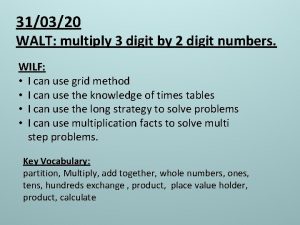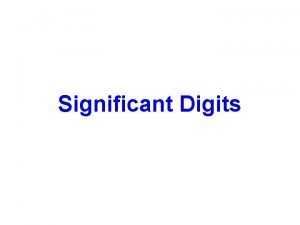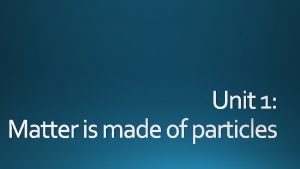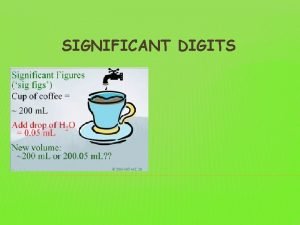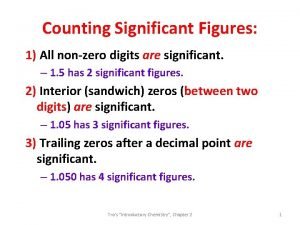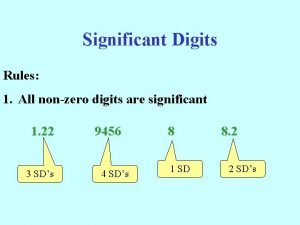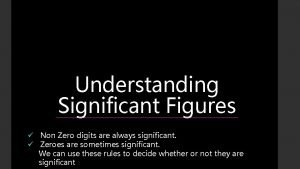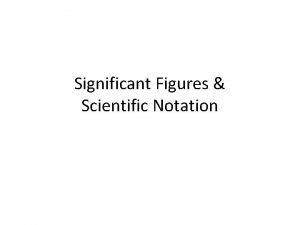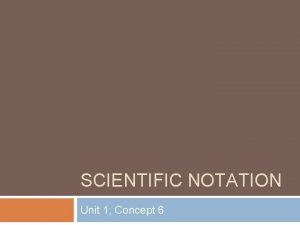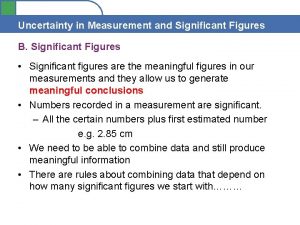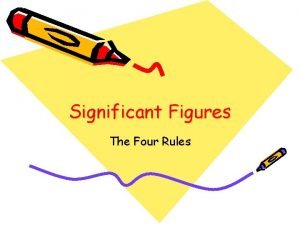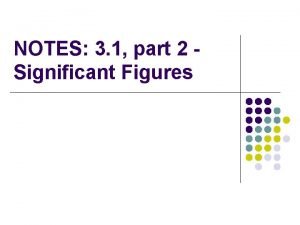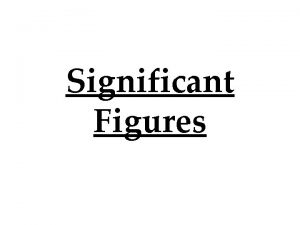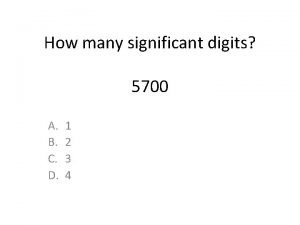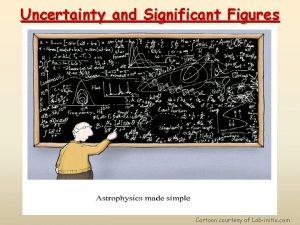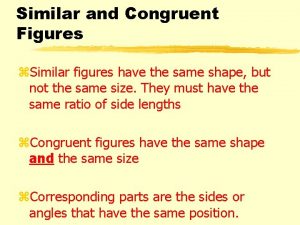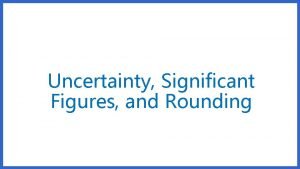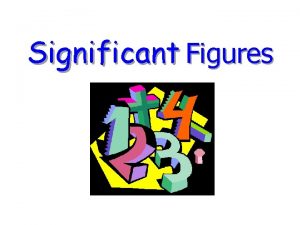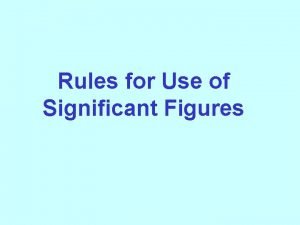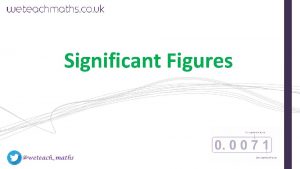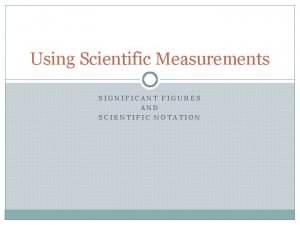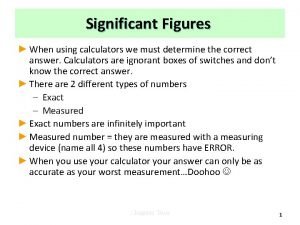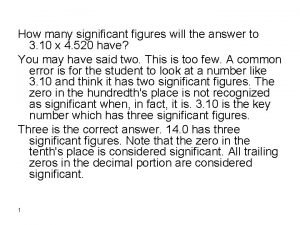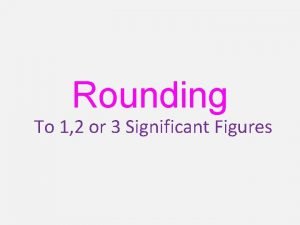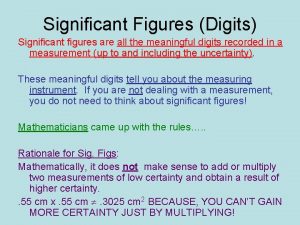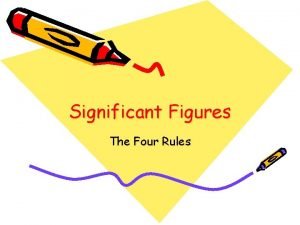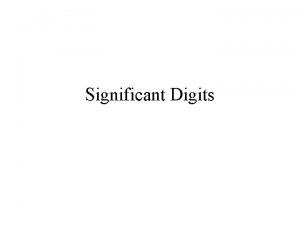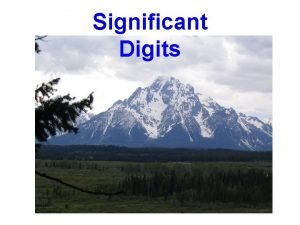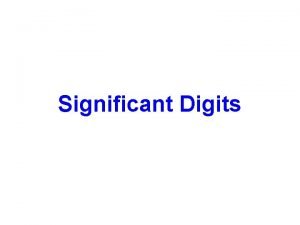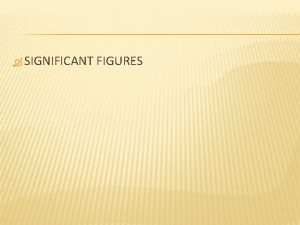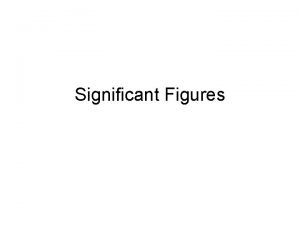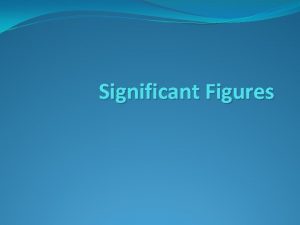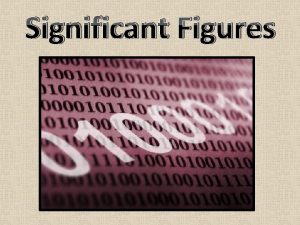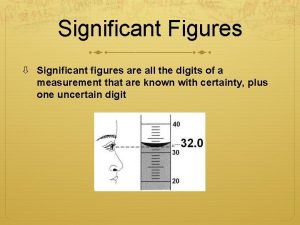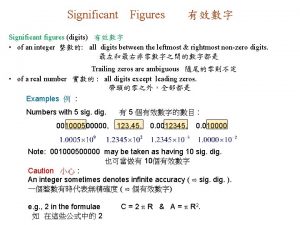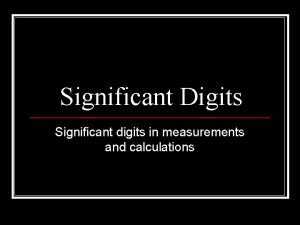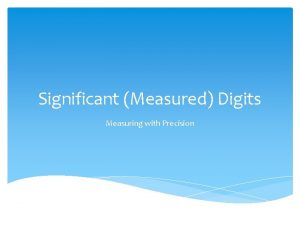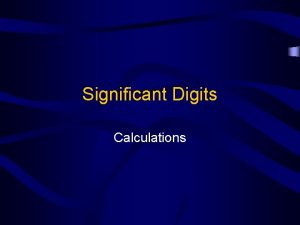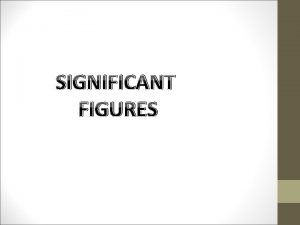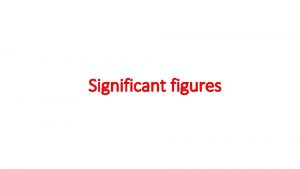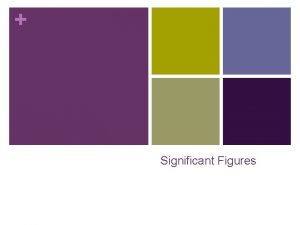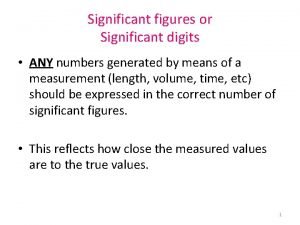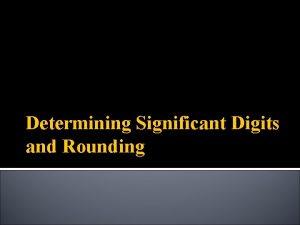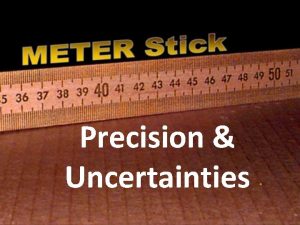Significant Digits or Figures How to recognize significant































- Slides: 31

Significant Digits or “Figures” • How to recognize significant figures when: – Taking a measurement – Reading a measurement – Performing a calculation

Accuracy and Precision in Measurements Accuracy: how close a measurement is to the accepted value. Precision: how close a series of measurements are to one another or how far out a measurement is taken. A measurement can have high precision, but not be as accurate as a less precise one.

Significant Figures are used to indicate the precision of a measured number or to express the precision of a calculation with measured numbers. In any measurement the digit farthest to the right is considered to be estimated. 0 1 2 1. 3 2. 0

Question For Thought Using two different rulers, I measured the width of my hand to be 4. 5 centimeters and 4. 54 centimeters. Explain the difference between these two measurements.

The first measurement implies that my hand is somewhere between 4. 5 and 4. 9 cm long. There is a uncertainty in this number because we have to estimate. The second measurement implies that my hand is between 4. 5 and 4. 6 cm long. This measurement is more certain due to its greater precision.

4. 5 cm 2 significant figures Uncertain 4. 54 cm 3 significant figures More certain due to greater precision Significant figures are necessary to reduce uncertainty in our measurements. Significant figures indicate the precision of the measured value!!

Significant Figures • Scientist use significant figures to determine how precise a measurement is • Significant digits in a measurement include all of the known digits plus one estimated digit • So when reading an instrument… – Read instrument to the last digit that you know – Estimate or “eyeball” the final digit

For example… • Look at the ruler below • Each line is 0. 1 cm • You can read that the arrow is on 13. 3 cm • However, using significant figures, you must estimate the next digit • That would give you 13. 30 cm

Let’s try this one • Look at the ruler below • • What can you read before you estimate? 12. 8 cm Now estimate the next digit… 12. 85 cm

Let’s try graduated cylinders • Look at the graduated cylinder • What can you read with confidence? = 56 ml • Now estimate the last digit = 56. 0 ml • What is this measurement? • _______

Recognizing # Sig Figs in a Number • All non zero digits are ALWAYS significant • How many significant digits are in the following numbers? 274 ______Significant Figures 25. 632 ______Significant Digits 8. 987 ______Significant Figures

• All zeros between significant digits are ALWAYS significant • How many significant digits are in the following numbers? 504 ____ Significant Figures 60002 ____ Significant Digits 9. 077 ____ Significant Figures

• All FINAL zeros to the right of the decimal ARE significant • How many significant digits are in the following numbers? 32. 0 ______Significant Figures 19. 000 ______Significant Digits 105. 0020 ______Significant Figures

All zeros that act as place holders are NOT significant Another way to say this is: zeros are only significant if they are between significant digits OR are the very final thing at the end of a decimal How many significant digits are in the following numbers? 0. 0002 6. 02 x 1023 100. 000 150000 800 _____Significant Digits _____Significant Digit

Numbers with no decimal are ambiguous. . . • Does 5000 ml mean exactly 5000? Maybe. . Maybe Not! • So 5000, 50, and 5 are all assumed to have 1 significant figure • If a writer means exactly 5000, he/she must write 5000. or 5. 000 x 103

• All counting numbers and constants have an infinite number of significant digits • For example: 1 hour = 60 minutes 12 inches = 1 foot 24 hours = 1 day

How many significant digits are in the following numbers? 0. 0073 100. 020 2500 7. 90 x 10 -3 670. 00001 18. 84 _______________ _______________

Here is a one sentence rule for counting sig figs: All digits ARE significant except Zeros preceding a decimal fraction (ex: 0. 0045) and Zeros at the end of a number containing NO decimal point (ex: 45, 000)

Calculations with Sig Figs • Adding or subtracting: – answer can have no more places after the decimal than the LEAST of the measured numbers. • Count # decimal places held – (nearest. 1? . 001? ) • Answer can be no more accurate than the LEAST accurate number that was used to calculate it.

For Example: 5. 50 grams + 8. 6 grams -------14. 1 grams 52. 09 ml - 49. 7 ml ------2. 39 ml --> 2. 4 ml

Calculations with Sig Figs • Multiplying or dividing: round result to least # of sig figs present in the factors – Answer can’t have more significant figures than the least reliable measurement. • COUNT significant figures in the factors

• 56. 78 cm x 2. 45 cm = 139. 111 cm 2 –Round to 3 sig figs = 139 cm 2 • 75. 8 cm x 9. 6 cm = ?

Now let’s do some math. . . (round answers to correct sig figs!) 5. 0033 g + 1. 55 g • answer: 6. 55 g Did you need to count sig figs? NO!

Try this one. . 4. 80 ml -. 0015 ml • answer: 4. 80 ml (one might say. 0015 is insignificant COMPARED TO 4. 80)

Now try these. . . 5. 0033 g / 5. 0 ml • answer: 1. 0 g/ml Did you have to count sig figs? • YES!

Here’s a tougher one. . . 3. 0 C/s x 60 s/min x 60 min/hr = • answer: 10800 C/hr rounds to 11000 C/hr Note: Standard conversion factors never limit sig. figures- instruments and equipment do.

Scientific Notation • Scientific notation is used to express very large or very small numbers • It consists of a number between 1 & 10 followed by x 10 to an exponent • Exponent can be determined by the number of decimal places you have to move to get only 1 number in front of the decimal

Large Numbers • If the number you start with is greater than 1, the exponent will be positive • Write the number 39923 in scientific notation • First move the decimal until 1 number is in front 3. 9923 • Now add x 10 • Now count the number of decimal places you moved (4) • Since the number you started with was greater than 1, the exponent will be positive • 3. 9923 x 10 4

Small Numbers • If the number you start with is less than 1, the exponent will be negative • Write the number 0. 0052 in scientific notation • First move the decimal until 1 number is in front = 5. 2 • Now add x 10 • Now count the number of decimal places moved (3) • Since the number you started with was less than 1, the exponent will be negative • 5. 2 x 10 -3

Scientific Notation Examples Place the following numbers in scientific notation Note: all sig figs from the original number must be present! 99. 343 _______ 4000. 1 _______ 0. 000375 _______ 0. 0234 _______ 94577. 1 _______

Going to Ordinary Notation Examples Place the following numbers in ordinary notation: 3 x 106 6. 26 x 109 5 x 10 -4 8. 45 x 10 -7 2. 25 x 103 ________________ ________
 Multiply 3 digits by 2 digits
Multiply 3 digits by 2 digits 4 rules of significant figures
4 rules of significant figures Significant figures
Significant figures When is zero a significant figure
When is zero a significant figure Significant digits
Significant digits Site:slidetodoc.com
Site:slidetodoc.com How many significant figures are in 2804
How many significant figures are in 2804 What counts as a significant figure
What counts as a significant figure All nonzero digits are not significant
All nonzero digits are not significant Are all non zero digits significant
Are all non zero digits significant What are significant digits in math
What are significant digits in math Unit 1 scientific notation worksheet answers
Unit 1 scientific notation worksheet answers Uncertainty in measurement and significant digits
Uncertainty in measurement and significant digits Rules for significant figures
Rules for significant figures 1 significant figure
1 significant figure All nonzero digits are significant
All nonzero digits are significant In 5700 significant figures
In 5700 significant figures Counting significant digits
Counting significant digits Washing machine solid or plane figure
Washing machine solid or plane figure Are congruent figures similar
Are congruent figures similar Plane figures
Plane figures Uncertain digit calculator
Uncertain digit calculator Sig figs in addition
Sig figs in addition 201 significant figures
201 significant figures 2021 significant figures
2021 significant figures Significant figures of whole numbers
Significant figures of whole numbers What is significant figure
What is significant figure How many significant figures in 980
How many significant figures in 980 Rounding to 2 significant figures
Rounding to 2 significant figures Addition rule of significant figures
Addition rule of significant figures 820 m significant figures
820 m significant figures Chemistry sig figs
Chemistry sig figs
